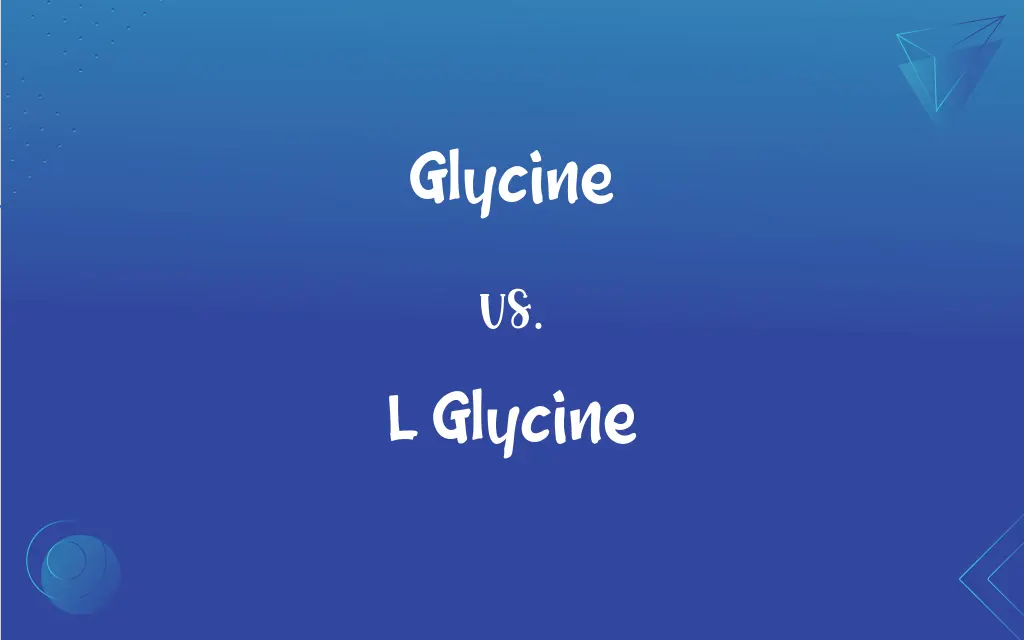Glycine vs. L Glycine: What's the Difference?
Edited by Aimie Carlson || By Harlon Moss || Published on February 21, 2024
Glycine is a simple, non-essential amino acid, while L-glycine refers to the specific L-enantiomer, the naturally occurring form of glycine in proteins.

Key Differences
Glycine, a non-essential amino acid, is unique among amino acids as it doesn't have stereoisomers due to its two hydrogen atom side chain. L-Glycine refers to the L-enantiomer configuration, common to all amino acids in proteins. However, in the case of glycine, there is no D-form because of its symmetrical structure.
Glycine is a building block of protein and is involved in various metabolic processes. L-glycine emphasizes the specific orientation (L-form) in which glycine is incorporated into proteins, which is standard for all amino acids in biological systems.
When referring to supplements or research, glycine is often used to mean L-glycine, as it is the biologically active form. However, specifying L-glycine can be important in scientific contexts to clarify the orientation being discussed or used.
Both glycine and L-glycine share the same chemical properties and functions in the body, including neurotransmission and the synthesis of other compounds. The distinction is more relevant in stereochemistry and the study of amino acid structures.
In nutrition and medicine, glycine generally refers to the common form found in food and the human body, which is L-glycine. The distinction is usually made in more specialized scientific or biochemical contexts.
ADVERTISEMENT
Comparison Chart
Molecular Structure
Simplest amino acid, no stereoisomers
Specific L-enantiomer of glycine
Biological Importance
Found in proteins, involved in metabolism
L-form used in protein synthesis
Use in Supplements
Generally refers to L-glycine
Explicitly specifies the L-form
Chemical Properties
Involved in neurotransmission, synthesis
Same as glycine, specific to L-orientation
Nutritional Relevance
Common form in food and body
Same as glycine, specified in scientific contexts
ADVERTISEMENT
Glycine and L Glycine Definitions
Glycine
A simple, non-essential amino acid.
Glycine is a key component in the structure of collagen.
L Glycine
Biologically active form of glycine in humans.
Supplements typically contain L-glycine, the form used by the body.
Glycine
Involved in protein synthesis and neurotransmission.
Glycine acts as an inhibitory neurotransmitter in the central nervous system.
L Glycine
The L-enantiomer form of glycine.
L-glycine is the form incorporated into proteins during synthesis.
Glycine
Found in high concentrations in gelatin and silk.
The high glycine content in gelatin contributes to its properties.
L Glycine
Important for protein structure and function.
L-glycine's role in collagen formation is crucial for skin and joint health.
Glycine
Does not have a chiral center.
Due to its symmetrical structure, glycine lacks stereoisomers.
L Glycine
Identical to glycine due to lack of chiral center.
L-glycine is used interchangeably with glycine in nutrition.
Glycine
Used in various metabolic pathways.
Glycine participates in the synthesis of heme, an important component of hemoglobin.
L Glycine
Specified in scientific contexts for clarity.
In biochemistry, L-glycine is specified to align with other amino acids' naming conventions.
Glycine
A sweet-tasting crystalline nonessential amino acid, C2H5NO2, that is the principal amino acid occurring in sugarcane. The simplest amino acid found in protein, it is derived from the alkaline hydrolysis of gelatin and used in biochemical research and medicine.
Glycine
(amino acid) A nonessential amino acid, amino-acetic acid, C2H5NO2 found in most proteins but especially in sugar cane; the simplest amino acid.
Glycine
The simplest amino acid found in proteins and the principal amino acid in sugar cane
Glycine
Genus of Asiatic erect or sprawling herbs: soya bean
FAQs
What is glycine?
A simple, non-essential amino acid, important in protein synthesis and metabolism.
In what foods is glycine found?
In protein-rich foods like meat, fish, dairy, and legumes.
What are the benefits of glycine supplementation?
Supports joint health, skin health, and neurotransmission.
Why is glycine unique among amino acids?
It lacks a chiral center, making it the simplest amino acid.
Can vegetarians get enough glycine?
Yes, though they may need to consume a variety of plant proteins.
Is L-glycine used in protein synthesis?
Yes, it's the form incorporated into proteins.
Is there a D-glycine?
No, glycine does not have a D-form due to its symmetry.
What role does glycine play in collagen?
It's a key component, giving collagen its structure and strength.
Does glycine have side effects?
Generally, it's well-tolerated, but large doses may cause gastrointestinal issues.
Are glycine and L-glycine chemically different?
No, they are chemically identical due to glycine’s non-chiral nature.
Is glycine important for sleep?
Yes, it can have calming effects on the brain and aid in sleep.
What is L-glycine?
The L-enantiomer of glycine, identical in structure due to glycine's lack of chirality.
How is glycine used in the body?
For protein construction, neurotransmission, and as a precursor to other compounds.
Does glycine help with joint health?
Yes, as part of collagen, it supports joint function and repair.
How is glycine produced in the body?
Through the conversion of serine and other biochemical pathways.
Is glycine supplementation necessary?
Not usually, as it's non-essential and found in many protein sources.
Can glycine improve skin elasticity?
Yes, through its role in collagen synthesis.
Why is L-glycine specified in supplements?
For consistency with other amino acids, though it's identical to glycine.
Can glycine help with muscle growth?
Indirectly, as part of overall protein intake and muscle repair processes.
Is L-glycine used in medical treatments?
It can be used in certain therapeutic applications, like improving skin health.
About Author
Written by
Harlon MossHarlon is a seasoned quality moderator and accomplished content writer for Difference Wiki. An alumnus of the prestigious University of California, he earned his degree in Computer Science. Leveraging his academic background, Harlon brings a meticulous and informed perspective to his work, ensuring content accuracy and excellence.
Edited by
Aimie CarlsonAimie Carlson, holding a master's degree in English literature, is a fervent English language enthusiast. She lends her writing talents to Difference Wiki, a prominent website that specializes in comparisons, offering readers insightful analyses that both captivate and inform.







































































